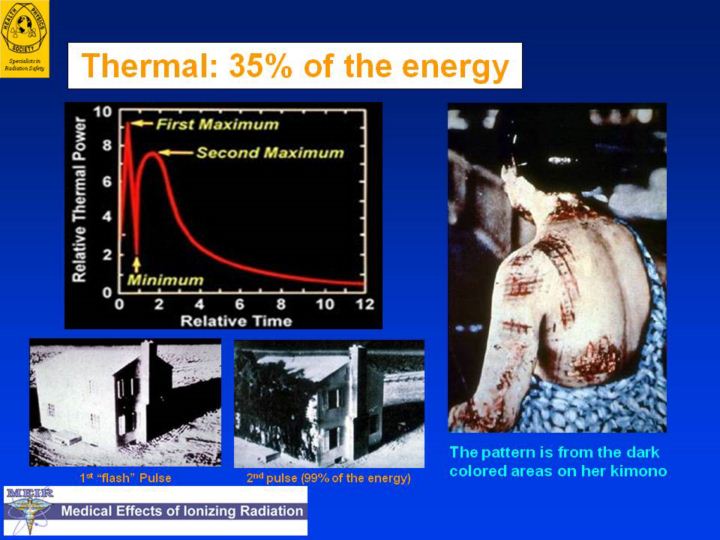| front |1 |2 |3 |4 |5 |6 |7 |8 |9 |10 |11 |12 |13 |14 |15 |16 |17 |18 |19 |20 |21 |22 |23 |24 |25 |26 |27 |28 |29 |30 |31 |32 |33 |34 |35 |36 |37 |38 |39 |40 |41 |42 |43 |44 |45 |46 |47 |48 |review |
 |
Thermal pulse . Immediately after an explosion, energy is emitted in the form of thermal radiation and, due to the extremely high temperatures, as x rays, which are absorbed within a few feet of air. The energy is then re-emitted and, due to certain phenomena occurring within the fireball, the secondary thermal radiation emission occurs in two pulses. First pulse. The first pulse lasts only about one tenth of a second. It consists of approximately 1 percent of the total thermal radiation release, and much of the thermal release is in the ultraviolet region. Although ultraviolet radiation can cause skin burns, it appears that this occurs only at ranges at which other thermal radiation effects are more serious. However, although this first pulse may be disregarded as a source of skin burns, it is capable of producing permanent or temporary effects on the eyes, especially if one is looking in the direction of the detonation at the time of the explosion. Second pulse. The second pulse lasts for several seconds and carries about 99 percent of the total thermal radiation energy. Since the temperature is lower than that in the first pulse, most of the rays reaching the Earth consist of visible and infrared light. This radiation is the main cause of various degrees of skin burns suffered by exposed individuals up to at least 12 miles.
Flash burns. This image of a Nagasaki woman shows flash burns in the pattern of the kimono she was wearing at the time of the blast. The light-colored fabric reflected the thermal radiation whereas the dark-colored fabric absorbed it and became hot, causing contact burns on the skin immediately beneath the fabric. Medical records indicate that, in some cases, dark-colored clothing actually burst into flames and ignited the undergarments, causing flame burns. It should be noted that light-colored clothing does NOT ensure total protection from thermal radiation. Some light-colored fabrics actually transmit enough thermal radiation to allow direct flash burning of the skin. |